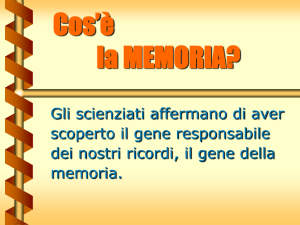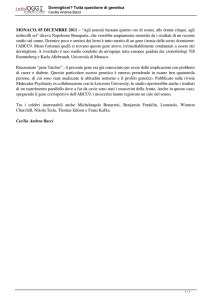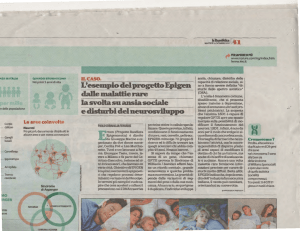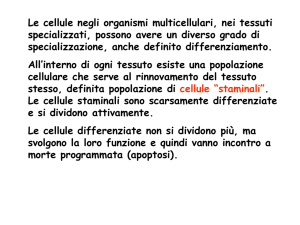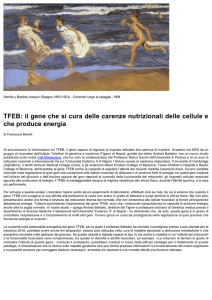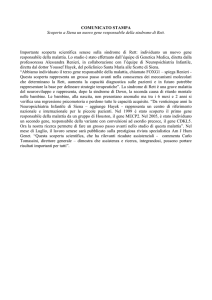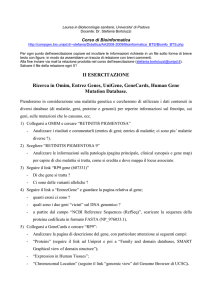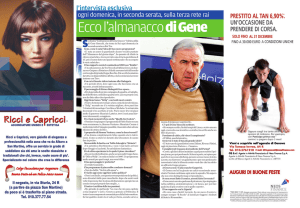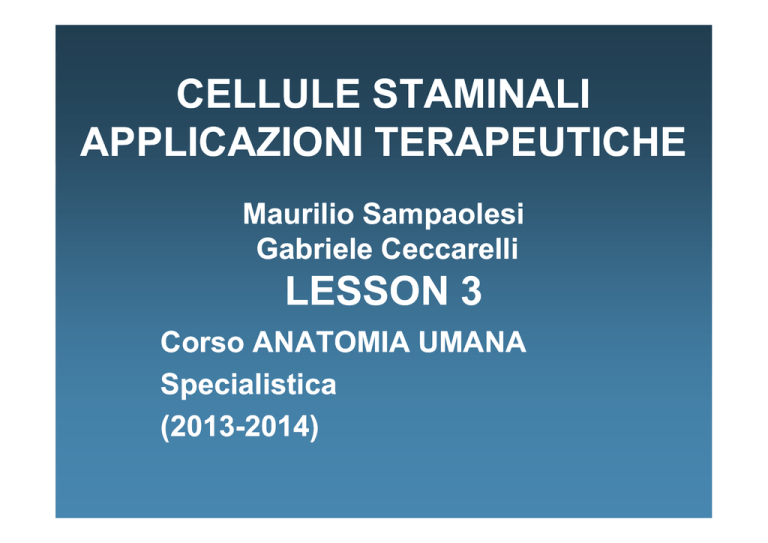
CELLULE STAMINALI
APPLICAZIONI TERAPEUTICHE
Maurilio Sampaolesi
Gabriele Ceccarelli
LESSON 3
Corso ANATOMIA UMANA
Specialistica
(2013--2014)
(2013
La durata del ciclo varia molto, soprattutto
nella lunghezza della fase G1. In una cellula
adulta può durare da 12 a 36 ore, la differenza
dipende dalla fase G1.
La fase G1 può durare ore, giorni, settimane o
più a lungo a seconda del tipo cellulare.
Quando la fase G1 si protrae a lungo, si parla
di Go, cioè una fase stazionaria di attesa.
L’ingresso da Go a G1 ed il passaggio da G1
a S richiede l’intervento di messaggi
ambientali, chiamati mitogeni o fattori di
crescita.
I meccanismi di controllo del ciclo cellulare:
da Go a G1: fattori di crescita
Transizione G1 - S: start point, preparazione
delle molecole necessarie per la duplicazione
del DNA
Transizione G2 – M: controllo quantitativo e
qualitativo dell’avvenuta duplicazione del DNA,
preparazione del fuso mitotico.
L’uscita da M e l’avvio della citochinesi
Ingresso nel ciclo:
l’aggiunta di fattori di crescita attiva
il passaggio tra la fase G0 e G1
Ingresso nel ciclo e
transizione G1-S:
il fattore di crescita attiva la
via di trasduzione del
segnale (Ras/MAPK) che
porta alla trascrizione
genica. Vengono prodotti
fattori trascrizionali (risposta
precoce), che a loro volta
regolano in cascata la
trascrizione di altre molecole
(risposta tardiva) che
permettono la transizione da
G1 ad S.
PDGF-R
Myc, Fos, Jun
E2F
Proliferazione
ciclina
Le cicline e le chinasi
ciclina dipendenti (CdK)
Le cicline sono
prodotte nella
risposta secondaria
e la loro presenza
attiva le chinasichinasiciclina dipendenti
Le cicline sono state identificate sia in cellule
di lievito che in cellule di mammifero.
La loro concentrazione aumenta sino ad un
livello massimo e poi segue una rapida
degradazione.
L’attività delle CdK è regolata dalla
concentrazione delle cicline.
Esistono vari tipi di cicline e vari tipi di Cdk.
Le varie cicline nelle cellule di mammifero
Ciclina A/Cdk2
Ciclina
E/Cdk2
Ciclina B/Cdk1
Ciclina D/Cdk2
ciclinaD/CdK4
Le Cdk attivate dalle cicline sono delle proteine
serina--treonina chinasi .
serina
Fosforilano substrati coinvolti nelle varie fasi del
ciclo, ad esempio nel passaggio tra G1 ed S,
fosforilano gli istoni e permettono la compattazione
dei cromosomi.
Oppure fosforilano la lamina nucleare,
disassemblandola e rompendo l’
l’involucro nucleare.
Altre proteine fosforilate sono quelle del
citoscheletro, che servono al macchinario della
divisione.
Il ciclo cellulare è controllato da segnali
positivi, cioè attivazione di geni,
produzione di cicline, ecc…
Ma esistono anche dei controlli negativi
della progressione nel ciclo, che devono
essere rimossi.
Un esempio è la proteina del
retinoblastoma (Rb), che in Go è associato
al fattore trascrizionale E2F, inattivandolo.
Nella transizione G1G1-S, le Cdk fosforilano
Rb, che di conseguenza si stacca da E2F
attivandolo e permettendogli di funzionare
come fattore trascrizionale.
La proteina del retinoblastoma
Le placche focali
La crescita tumorale dipende da una dede-regolazione dei
meccanismi che controllano la crescita, il
differenziamento e la morte cellulare.
Controllo normale ed alterato della produzione di
cellule a partire da cellule staminali.
Iperattività di un gene capace di stimolare la
proliferazione: mutazione con effetto dominante (basta
che muti una copia del gene): il gene alterato è
(l’’allele dominante è chiamato
chiamato oncogene (l
protooncogene).
Inattivazione di un gene inibitore: mutazione con
effetto recessivo (devono essere distrutte entrambe le
copie del gene): il gene è chiamato gene soppressore
della crescita tumorale.
tumorale.
I soppressori tumorali
Saggio di
identificazione di
oncogeni in tumori
umani di origine
spontanea
La proliferazione delle cellule in vitro
Inibizione da contatto
La dipendenza da ancoraggio
Anomalie nella membrana: formazione di
vescicole e di proteine di membrana
citoplasmatica
Anomalie nelle proprietà adesive: minore
adesione, forma arrotondata, mancata
formazione delle fibre di stress, aumentata
proteolisi extracellulare
Anomalie della crescita e della divisione:
crescita ad alta densità, ridotto fabbisogno
di fattori di crescita, minore dipendenza ad
ancoraggio, “immortale”
immortale”, inducono tumori
in animali da esperimento
La sintesi del DNA:
incorporazione di BdUR
e analisi al citofluorimetro
Durante la fase S ogni cromosoma (molecola di
DNA) viene duplicato e ogni copia completa
(cromatide) resta unita all’
all’altra per la zona
centrale del centromero sino alla fase M.
Ciascun
cromatide
contiene una
delle due
molecole di
DNA generate
nella fase S di
replicazione
del DNA
Le fasi del ciclo cellulare:
interfase e mitosi
Cancer; a definition
-A growth (enlargement) composed of a clonal population of
cells that has acquired the ability to expand in defiance of the
checks and balances that would normally control the proliferation
and survival of normal cells (neo(neo-plastic).
-The genetic changes in a tumor cell were acquired sequentially.
The appropriate combination of mutations resulted in a competitive
advantage of a clone of cells over a number of competing clones.
The clonally selected population will compose the majority of a
tumor in one site.
-While the number of genetic lesions vary, it is clear that the
transformation of a cell involves multiple mutations (n>2, at least).
The clonal evolution of
tumor cell populations
Acquired genetic liability permits
stepwise selection of variant sublines
an underlies tumor progression
Science 194, 2323-28 (1976)
Peter Nowell’
Nowell’s original
observation was based
on the detection of the
translocation between
chromosome 9 and 22 in
CML. The truncated version
of chr. 22 was named the
Philadelphia Chr.
Peter C. Nowell
Genetic complexity
of genomicallygenomically-unstable
tumor cells
Terms for the road…
Oncogene:: the hyperactive version of a gene whose normal form
Oncogene
(proto-oncogene) is involved in the regulation of cellular proliferation
(protoand/or survival. This alteration is a dominant genetic event.
Tumor supressor: a gene whose normal function involves the
inhibition of cell growth and/or survival. The loss of both copies of this
gene result in the uninhibited growth of the cell. This is a recessive
genetic event.
Identification of oncogenes by three independent lines of study:
-transforming retroviruses (Bishop and Varmus)
-Gene transfer experiments from tumor cells (Weinberg and others)
-Molecular cloning of chromosomal breakpoints
(Cory, Korsmeyer, Croce, etc)
transforming retroviruses
Development of inin-vitro systems to study cellular transformation:
the chickchick-embryo fibroblast model
Transformed by v-src
Wild--type
Wild
transforming retroviruses
Transforming retroviruses were able to render Chicken
Embryonic Fibroblasts (CEFs) resistant to densitydensity-dependent
inhibition of proliferation
Transforming retroviruses
transforming retroviruses
-first documented instance: P. Rous and RSV in chickens (1923).
-Following serial passage in vitro, identified a mutant virus that
was able to propagate but no longer caused tumors. This suggested
that the viral “oncogene
oncogene”
” was genetic “baggage
baggage”” that was dispensable
for viral pathogenesis and replication.
-The gene was eventually cloned and named src.
src.
-Low stringency Southern blotting showed that the viral oncogene
had a closely related counterpart in the host’
host’s genome. The normal
gene (termed c-src)
src) was partially picked up by the virus during some
recombination event, and altered by partial sequence incorporation
into the viral genome.
-Viral oncogenes have helped identify numerous cellular
proto--oncogenes
proto
Oncogenes originally identified through
their presence in retroviruses
transforming retroviruses
Oncogene
ProtoProto-oncogene
function
Source of virus
VirusVirus-induced
tumor
abl
Protein tyrosine
kinase (PTK)
Mouse/cat
PrePre-B-cell leukemia
erberb-B
EGF--receptor (RTK)
EGF
chicken
Erythroleukemia,
fibrosarcoma
fes
(PTK)
Cat/chicken
sarcoma
fms
GMCSF--R (PTK)
GMCSF
cat
sarcoma
fos/jun
APAP-1 transcription
factor
Mouse/chicken
Osteosarcoma,
fibrosarcoma
kit
Stem cell factor (SCF)
cat
sarcoma
raf
PTK
Chicken/mouse
sarcoma
myc
Transcription
regulator
chicken
Sarcoma,
myelocytoma,
carcinoma
H-ras
GTP--binding protein
GTP
rat
Erythroleukemia,
sarcoma
rel
Regulator of NFNF-kB
turkey
reticuloendotheliosis
sis
PDGF--b
PDGF
monkey
sarcoma
src
PTK
chicken
sarcoma
akt
PTK
mouse
T-cell leukemia
transforming retroviruses
Alternative mechanism of retrovirallyretrovirally-induced transformation:
Insertional mutagenesis of host genes.
-the retroviral genome is reverse transcribed and integrated into the
cellular genome.
-The insertion of a retroviral LTR sequence upstream from a
proto--oncogene may result in the ectopic expression, or
proto
overexpression of such a gene without any overt mutation to its
nucleotide sequence. This may also happen over large stretches
of genomic DNA (up to 10 KB away!).
-The insertion of a retroviral genome may also disrupt an ORF,
such as that of a tumor supressor gene, extinguishing its expression.
Gene transfer exp
Identification of oncogenes by transfection of DNA derived from
tumor cells into fibroblasts.
-transfected DNA obtained from human tumors into a “non
non--transformed
transformed””
context (murine 3T3 cells).
-Isolated clones with transforming function.
-Define the minimal essential fragment of DNA required to
confer the phenotype.
-Identified several dysregulated oncogenes that had been
previously found encoded in transforming retroviruses.
-Classically defined oncogenes by transfection approach were the
various members of the Ras family (H, K and NN-Ras).
Mechanisms of dysregulation of protoproto-oncogenes in cancer
Example of gene amplification:
The c-myc locus in a case
of BB-NHL
Mol Clon of Chr breakpoints
Mol Clon of Chr breakpoints
What about tumor suppressor
genes?
Alfred G. Knudson Jr. - statistical study of retinoblastoma:
“retinoblastoma is a cancer caused by two mutational events. In the
dominantly inherited form, one mutation is inherited via the germ
cell and the second occurs somatically. In the nonhereditary form,
both mutations occur somatically.”
somatically.”
“ Using Poisson statistics, one can calculate that this number (three)
can explain the occassional gene carrier who gets no tumor, those
who develop bilateral tumors, as well as explaining instances of
multiple tumors in one eye”
eye”
Proc. Natl. Acad. Sci. USA 68, 820820-823 (1971)
What about tumorigenic viruses?
-there are a number of viruses that have been shown to encode
viral oncogenes.
-For all of the viruses associated with human cancers, the
number of people infected is much larger than those that
develop cancer: the virally encoded oncogenes need to
cooperate with an additional mutation in the host.
-Some tumortumor-associated viruses act indirectly: HIV aliminates
the TT-cell element of the immune response, facilitating the
process of tumorigenesis by eliminating the steps of
immunoselection.
Summary
-Cancer is an abnormal growth of a clonal population of cells that
harbor several mutations in genes that normally regulate cellular
growth, survival and differentiation.
-Oncogenes are the dysregulated form of genes that normally
act as positive regulators of cellular growth and dependence on
extracellular cues. These are dominant mutations.
-Tumor suppressor genes are recessive mutations of genes
whose normal function is probably negative regulation of cellular
growth, and whose absence in a transformed cell provides a
competitive advantage.
-Oncogenes can be dysreguated by point mutations, gene amplification
chromosomal translocation and/or fusion to other ORFs, truncation, or
overexpression due to point mutations in transcriptional regulatory
regions of the locus.
-Tumor suppressor genes require the loss of both alleles in order to
exert their effect. Hereditary predisposition is associated with the germline
loss of one allele, and somatic loss of the second allele.

